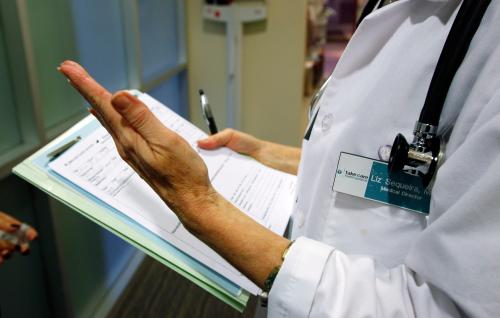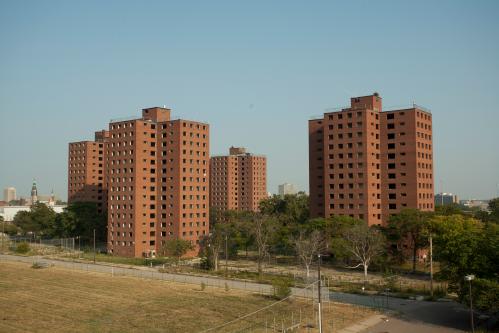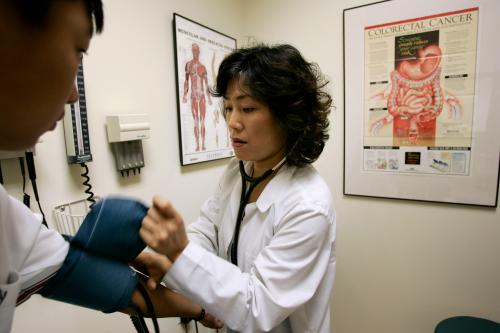The following is an excerpt from Reopening America: How to Save Lives and Livelihoods, a report published May 28, 2020 where Brookings experts offer ideas to help policymakers protect lives and save livelihoods in the midst of the current COVID-19 pandemic.
 Parts of the U.S. health system have been badly battered financially during the COVID-19 crisis, including hospitals that had to cancel lucrative elective surgery and cashstarved clinics that furloughed staff as reimbursed routine visits dried up while uncompensated care surged. But healthcare is not like retailing or the hospitality industry. Total health industry revenue is likely to rise this year at least modestly, and count for a significantly higher proportion of GDP. In total revenue and employment terms, it should be relatively easy to get back to normal. In the current situation, the real challenge is to make sure the health system does not return to normal.
Parts of the U.S. health system have been badly battered financially during the COVID-19 crisis, including hospitals that had to cancel lucrative elective surgery and cashstarved clinics that furloughed staff as reimbursed routine visits dried up while uncompensated care surged. But healthcare is not like retailing or the hospitality industry. Total health industry revenue is likely to rise this year at least modestly, and count for a significantly higher proportion of GDP. In total revenue and employment terms, it should be relatively easy to get back to normal. In the current situation, the real challenge is to make sure the health system does not return to normal.
COVID-19 showed starkly that our health system is riddled with inequities that literally killed people in the last few months. It laid bare the fact that chronic disease and health vulnerability track closely with race, zip code, low-paid service sector employment, substandard housing conditions, and other social determinants of health. As we rebuild, we must focus on creating a new normal and building a more equitable public health.
INTEGRATING SERVICES
Fixing all the factors that contribute to health inequities is a staggering undertaking, and politically daunting under the foreseeable economic and budget conditions. But the COVID-19 experience has underscored several ways we can make a start to rebalance the health system. The core of a rebalancing strategy should be to improve the health of more vulnerable households by integrating medical with nonmedical services, such as housing, social services, and long-term care supports. Public policy should be designed to expand opportunities to deliver services outside clinical settings, including schools and housing projects serving as hubs. Combining such services is common in many developed countries. The United States is the outlier among OECD countries in spending so heavily on medical services relative to social services—and has generally poorer health outcomes.
California’s Whole Person Care program (WPC) is an example of what should be considered more broadly as part of rebalancing the health system as we reopen the economy. WPC currently consists of 25 pilot programs that combine medical and social needs at the county level for the most vulnerable Medicaid beneficiaries, using multidisciplinary staff, interagency partnerships, and improved data sharing. Hundreds of organizations across the country, known as Area Agencies on Aging, adopt a similar approach for the elderly.
Reliable evaluation research to guide a national strategy of integrated services is improving but 23 still insufficient. Thus, including more and better evaluations will be important as we reconstitute the health system for the post-COVID-19 economy.
EXPANDING TELEHEALTH
With the need to avoid risky medical encounters, the COVID-19 pandemic has triggered a dramatic surge in the use of telehealth. Recent changes in federal rules have made non-office consultations much easier. Among other things, patients and physicians can use more popular platforms, such as Skype and iMessage. In addition, the government issued a temporary waiver allowing telehealth to be used across state lines if the state agrees, and Medicare adjusted its payment schedule to make telemedicine more attractive for physicians to use virtual visits. Private plans have been following suit.
These emergency changes should not be reversed when the crisis eases. The expansion of telehealth underscores the fact that many medical encounters can take place outside costly hospital settings. That has been especially important for improving the availability and quality of services to people and places that have long been chronically underserved. Hourly paid workers facing lengthy journeys to a physician’s office now have an alternative. Obstetricians and nurses can do routine check-ins by iPhone with women unable to take off work, and dermatologists can quickly identify skin conditions that warrant an in-person visit.
…as physicians and patients become more familiar with procedures, and as the technology improves, telehealth can become a powerful vehicle for delivering better healthcare — especially for many who today are systematically underserved.
It is true that the expansion of telehealth raises some concerns, such as the potential for fraud and the possibility of inferior services. But as physicians and patients become more familiar with procedures, and as the technology improves, telehealth can become a powerful vehicle for delivering better healthcare—especially for many who today are systematically underserved. It is time for a comprehensive overhaul of telehealth regulation and payments to make that possible. Going back to the pre-crisis structure would be a big mistake.
IMPROVING CARE FOR FRAIL OLDER ADULTS
A wide range of services typically is needed to maintain health and happiness as we age, including social services and connections that come with a familiar community. For many Americans, however, and not just for those in low-income households, the typical path leads to an unfamiliar Medicaid-funded nursing home or inadequate home care.
Successful aging requires flexibility in where and how services are provided, and more emphasis on home-based and integrated services. There has been progress to build on. For instance, changes in the rules for Medicare Advantage plans in 2018 allowed plans to pay for a wider range of non-clinical services, such as non-urgent transportation, home-delivered meals, and occasionally even air conditioners. Meanwhile some states, such as Vermont, have taken steps to coordinate social and health services to enable more seniors to age in their homes.
About 12 million Americans receive some level of home care, and almost a million more live in long-stay nursing homes. COVID-19 revealed just how dependent nursing home and homebased care is on a vulnerable workforce. Homebased professional caregivers in particular are a workforce under stress. Many work several jobs, over 30 percent are immigrants, more than half have no formal education beyond high school, and their hourly median earnings in 2018 were less than $12. Almost half are in poverty or close to it, and depend on Medicaid, housing benefits, and other assistance. And many work as contractors in a fragmented industry or exist in the informal economy. Not surprisingly, the combination of COVID-19 dangers and immigration restrictions, including the 2019 public charge rule, makes nursing home and home-based care an even more precarious occupation and puts caregivers and homecare agencies at financial risk.
Two steps are needed if we are to re-engineer this part of the healthcare system within a post COVID-19 economy. The first is to increase Medicaid and Medicare payments to improve the pay level and skills of direct care workers, and the second is to overhaul the training and regulation of these workers. There are several job classifications, and each is regulated to perform specific home care and clinical services. The workforce is regulated by the federal Department of Labor and by individual states, and training requirements vary by state. Meanwhile, in many states direct care workers are prevented from providing very basic medically related services, such as medication administration. The restrictions mean agencies or private payers often must pay for more than one professional to care for a client, and effectively cap the training and pay levels available for direct care workers.
COVID-19 caused many states to temporarily modify or suspend occupational licensing laws for medical personnel to fill gaps during the emergency. Going forward, there should be an overhaul of occupational licensing by states and training for both nurses and care workers to provide greater professional opportunities for home care workers. But this needs to be coupled with improved pay levels, or more qualified workers will leave home care for the hospital system to secure better pay.
PROVIDING MORE FLEXIBILITY IN HEALTH SPENDING
The COVID-19 crisis forced rapid adaptation in the health system, and both states and the federal government had to use program funds more flexibly. States moved swiftly to request waivers from the rules governing Medicaid and other program spending, and the federal government acted quickly on most requests.
To build a health system that reflects a greater emphasis on public health, equity, and integrated services, governments at all levels will need to adopt a variety of existing tools and create bodies to “braid and blend” funds. More waivers are an example. Versions of the Medicaid waiver granted to North Carolina in late 2018 is a good example to consider in other states; it allowed the state to create pilots for groups of high-cost, high-risk beneficiaries, and to provide enhanced case management that melds clinical services with housing, food, transportation, and other services.
A concern with federal waivers is always that they reflect the agenda of the administration at the time. For a more powerful, consistent, and lasting commitment to public health, Congress should consider an enhanced version of waivers that I and my Brookings colleague Henry Aaron proposed in 2004, in the context of expanding coverage. A feature of our proposal was a bipartisan waiver body, or commission, with members representing states as well as Congress and the administration. The commission would review state submissions and propose, for expedited action in Congress, packages of state-specific legislative changes in existing programs to allow states to pursue a national goal in a variety of ways. An appropriate national goal today would surely be an integrated-service approach to better and more equitable public health in America.







Commentary
Reopening America: Creating a more equitable healthcare system
July 7, 2020